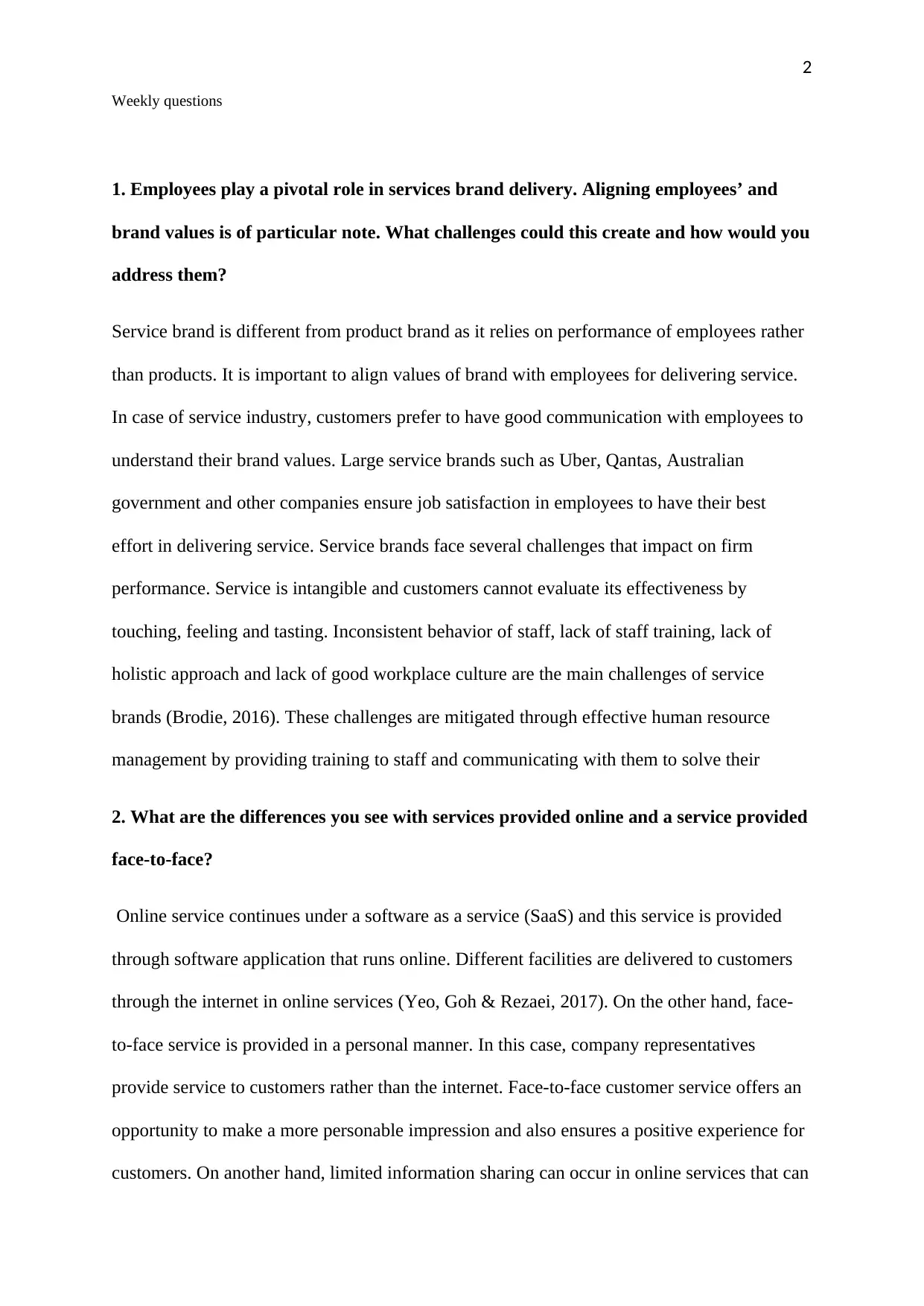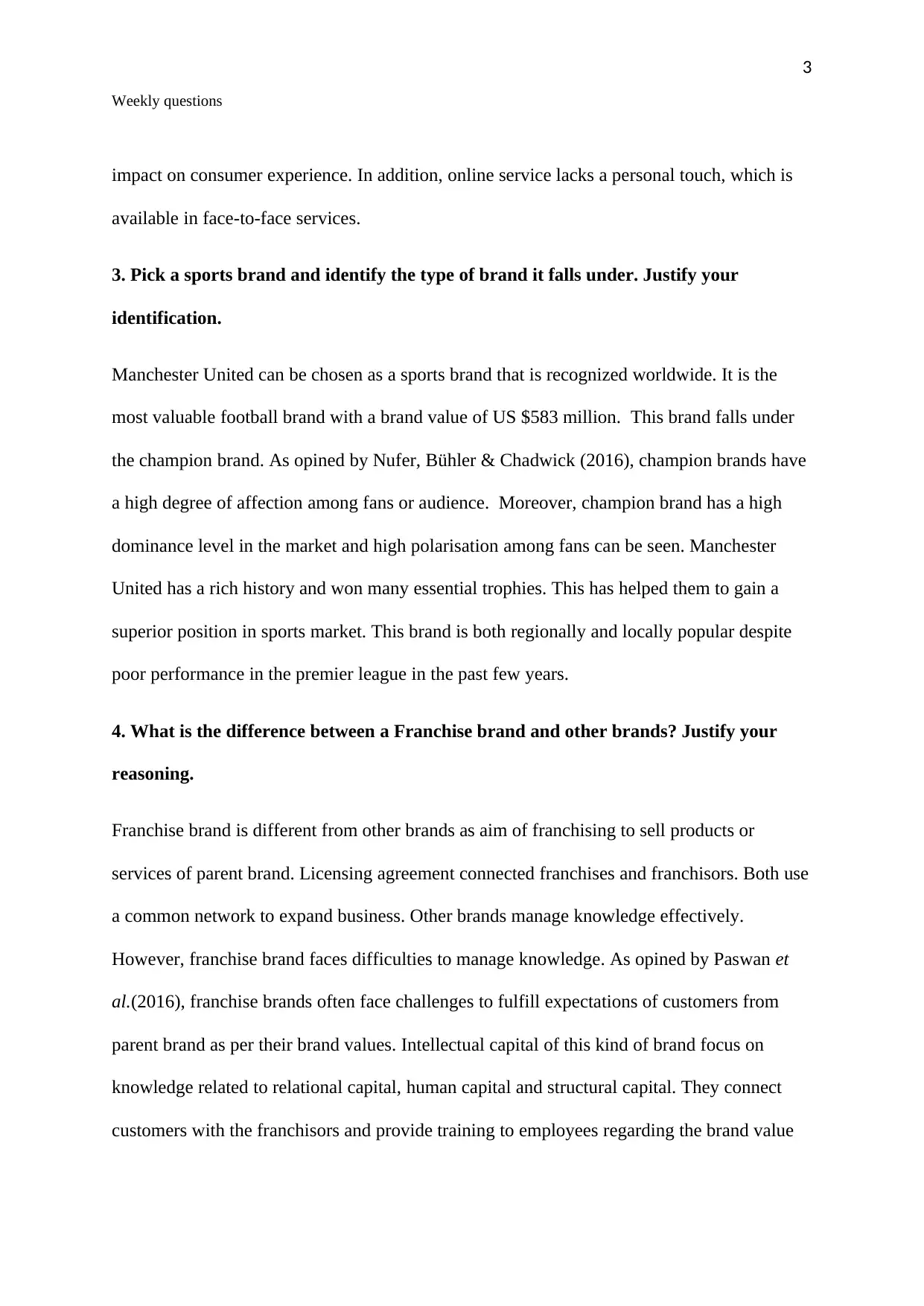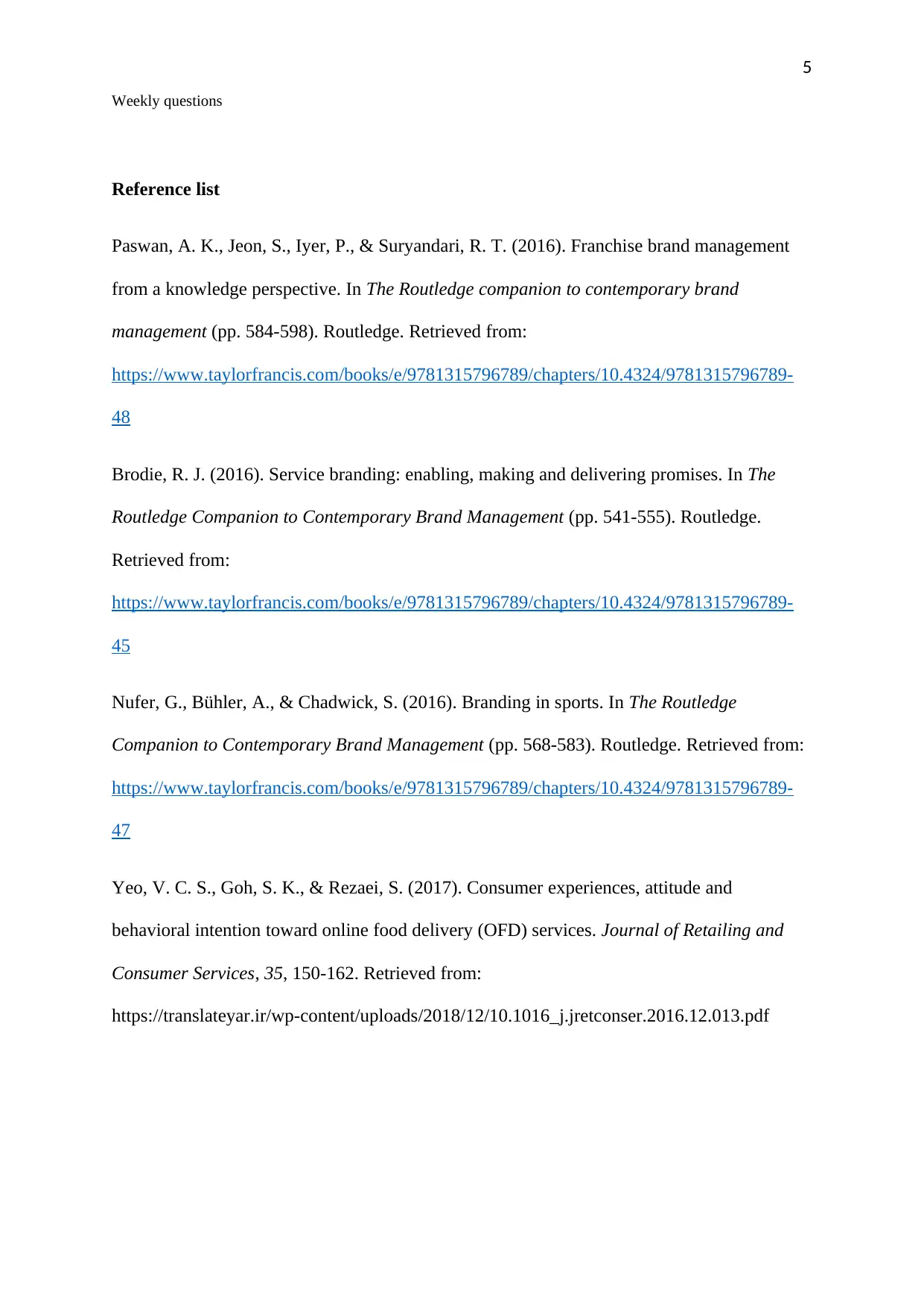Brand Management Weekly Questions Assignment - Winter 2018, Class 6
VerifiedAdded on 2022/11/23
|6
|855
|196
Homework Assignment
AI Summary
This assignment addresses four key questions related to brand management. The first question explores the challenges of aligning employee and brand values in service delivery, emphasizing the importance of employee satisfaction and training. The second question contrasts online and face-to-face service delivery, highlighting the differences in customer experience and information sharing. The third question analyzes Manchester United as a champion brand, justifying its high brand value and market dominance. The final question differentiates between franchise brands and other brands, focusing on knowledge management and the importance of aligning with the parent brand's values. The assignment utilizes relevant academic references to support the analysis.

Running head: Weekly questions
WEEKLY QUESTIONS
WEEKLY QUESTIONS
Paraphrase This Document
Need a fresh take? Get an instant paraphrase of this document with our AI Paraphraser

2
Weekly questions
1. Employees play a pivotal role in services brand delivery. Aligning employees’ and
brand values is of particular note. What challenges could this create and how would you
address them?
Service brand is different from product brand as it relies on performance of employees rather
than products. It is important to align values of brand with employees for delivering service.
In case of service industry, customers prefer to have good communication with employees to
understand their brand values. Large service brands such as Uber, Qantas, Australian
government and other companies ensure job satisfaction in employees to have their best
effort in delivering service. Service brands face several challenges that impact on firm
performance. Service is intangible and customers cannot evaluate its effectiveness by
touching, feeling and tasting. Inconsistent behavior of staff, lack of staff training, lack of
holistic approach and lack of good workplace culture are the main challenges of service
brands (Brodie, 2016). These challenges are mitigated through effective human resource
management by providing training to staff and communicating with them to solve their
2. What are the differences you see with services provided online and a service provided
face-to-face?
Online service continues under a software as a service (SaaS) and this service is provided
through software application that runs online. Different facilities are delivered to customers
through the internet in online services (Yeo, Goh & Rezaei, 2017). On the other hand, face-
to-face service is provided in a personal manner. In this case, company representatives
provide service to customers rather than the internet. Face-to-face customer service offers an
opportunity to make a more personable impression and also ensures a positive experience for
customers. On another hand, limited information sharing can occur in online services that can
Weekly questions
1. Employees play a pivotal role in services brand delivery. Aligning employees’ and
brand values is of particular note. What challenges could this create and how would you
address them?
Service brand is different from product brand as it relies on performance of employees rather
than products. It is important to align values of brand with employees for delivering service.
In case of service industry, customers prefer to have good communication with employees to
understand their brand values. Large service brands such as Uber, Qantas, Australian
government and other companies ensure job satisfaction in employees to have their best
effort in delivering service. Service brands face several challenges that impact on firm
performance. Service is intangible and customers cannot evaluate its effectiveness by
touching, feeling and tasting. Inconsistent behavior of staff, lack of staff training, lack of
holistic approach and lack of good workplace culture are the main challenges of service
brands (Brodie, 2016). These challenges are mitigated through effective human resource
management by providing training to staff and communicating with them to solve their
2. What are the differences you see with services provided online and a service provided
face-to-face?
Online service continues under a software as a service (SaaS) and this service is provided
through software application that runs online. Different facilities are delivered to customers
through the internet in online services (Yeo, Goh & Rezaei, 2017). On the other hand, face-
to-face service is provided in a personal manner. In this case, company representatives
provide service to customers rather than the internet. Face-to-face customer service offers an
opportunity to make a more personable impression and also ensures a positive experience for
customers. On another hand, limited information sharing can occur in online services that can

3
Weekly questions
impact on consumer experience. In addition, online service lacks a personal touch, which is
available in face-to-face services.
3. Pick a sports brand and identify the type of brand it falls under. Justify your
identification.
Manchester United can be chosen as a sports brand that is recognized worldwide. It is the
most valuable football brand with a brand value of US $583 million. This brand falls under
the champion brand. As opined by Nufer, Bühler & Chadwick (2016), champion brands have
a high degree of affection among fans or audience. Moreover, champion brand has a high
dominance level in the market and high polarisation among fans can be seen. Manchester
United has a rich history and won many essential trophies. This has helped them to gain a
superior position in sports market. This brand is both regionally and locally popular despite
poor performance in the premier league in the past few years.
4. What is the difference between a Franchise brand and other brands? Justify your
reasoning.
Franchise brand is different from other brands as aim of franchising to sell products or
services of parent brand. Licensing agreement connected franchises and franchisors. Both use
a common network to expand business. Other brands manage knowledge effectively.
However, franchise brand faces difficulties to manage knowledge. As opined by Paswan et
al.(2016), franchise brands often face challenges to fulfill expectations of customers from
parent brand as per their brand values. Intellectual capital of this kind of brand focus on
knowledge related to relational capital, human capital and structural capital. They connect
customers with the franchisors and provide training to employees regarding the brand value
Weekly questions
impact on consumer experience. In addition, online service lacks a personal touch, which is
available in face-to-face services.
3. Pick a sports brand and identify the type of brand it falls under. Justify your
identification.
Manchester United can be chosen as a sports brand that is recognized worldwide. It is the
most valuable football brand with a brand value of US $583 million. This brand falls under
the champion brand. As opined by Nufer, Bühler & Chadwick (2016), champion brands have
a high degree of affection among fans or audience. Moreover, champion brand has a high
dominance level in the market and high polarisation among fans can be seen. Manchester
United has a rich history and won many essential trophies. This has helped them to gain a
superior position in sports market. This brand is both regionally and locally popular despite
poor performance in the premier league in the past few years.
4. What is the difference between a Franchise brand and other brands? Justify your
reasoning.
Franchise brand is different from other brands as aim of franchising to sell products or
services of parent brand. Licensing agreement connected franchises and franchisors. Both use
a common network to expand business. Other brands manage knowledge effectively.
However, franchise brand faces difficulties to manage knowledge. As opined by Paswan et
al.(2016), franchise brands often face challenges to fulfill expectations of customers from
parent brand as per their brand values. Intellectual capital of this kind of brand focus on
knowledge related to relational capital, human capital and structural capital. They connect
customers with the franchisors and provide training to employees regarding the brand value
⊘ This is a preview!⊘
Do you want full access?
Subscribe today to unlock all pages.

Trusted by 1+ million students worldwide

4
Weekly questions
of parent company. On the other hand, other brands perform to enhance brand recognition
and they are self-operated businesses.
Weekly questions
of parent company. On the other hand, other brands perform to enhance brand recognition
and they are self-operated businesses.
Paraphrase This Document
Need a fresh take? Get an instant paraphrase of this document with our AI Paraphraser

5
Weekly questions
Reference list
Paswan, A. K., Jeon, S., Iyer, P., & Suryandari, R. T. (2016). Franchise brand management
from a knowledge perspective. In The Routledge companion to contemporary brand
management (pp. 584-598). Routledge. Retrieved from:
https://www.taylorfrancis.com/books/e/9781315796789/chapters/10.4324/9781315796789-
48
Brodie, R. J. (2016). Service branding: enabling, making and delivering promises. In The
Routledge Companion to Contemporary Brand Management (pp. 541-555). Routledge.
Retrieved from:
https://www.taylorfrancis.com/books/e/9781315796789/chapters/10.4324/9781315796789-
45
Nufer, G., Bühler, A., & Chadwick, S. (2016). Branding in sports. In The Routledge
Companion to Contemporary Brand Management (pp. 568-583). Routledge. Retrieved from:
https://www.taylorfrancis.com/books/e/9781315796789/chapters/10.4324/9781315796789-
47
Yeo, V. C. S., Goh, S. K., & Rezaei, S. (2017). Consumer experiences, attitude and
behavioral intention toward online food delivery (OFD) services. Journal of Retailing and
Consumer Services, 35, 150-162. Retrieved from:
https://translateyar.ir/wp-content/uploads/2018/12/10.1016_j.jretconser.2016.12.013.pdf
Weekly questions
Reference list
Paswan, A. K., Jeon, S., Iyer, P., & Suryandari, R. T. (2016). Franchise brand management
from a knowledge perspective. In The Routledge companion to contemporary brand
management (pp. 584-598). Routledge. Retrieved from:
https://www.taylorfrancis.com/books/e/9781315796789/chapters/10.4324/9781315796789-
48
Brodie, R. J. (2016). Service branding: enabling, making and delivering promises. In The
Routledge Companion to Contemporary Brand Management (pp. 541-555). Routledge.
Retrieved from:
https://www.taylorfrancis.com/books/e/9781315796789/chapters/10.4324/9781315796789-
45
Nufer, G., Bühler, A., & Chadwick, S. (2016). Branding in sports. In The Routledge
Companion to Contemporary Brand Management (pp. 568-583). Routledge. Retrieved from:
https://www.taylorfrancis.com/books/e/9781315796789/chapters/10.4324/9781315796789-
47
Yeo, V. C. S., Goh, S. K., & Rezaei, S. (2017). Consumer experiences, attitude and
behavioral intention toward online food delivery (OFD) services. Journal of Retailing and
Consumer Services, 35, 150-162. Retrieved from:
https://translateyar.ir/wp-content/uploads/2018/12/10.1016_j.jretconser.2016.12.013.pdf

6
Weekly questions
Weekly questions
⊘ This is a preview!⊘
Do you want full access?
Subscribe today to unlock all pages.

Trusted by 1+ million students worldwide
1 out of 6
Related Documents
Your All-in-One AI-Powered Toolkit for Academic Success.
+13062052269
info@desklib.com
Available 24*7 on WhatsApp / Email
![[object Object]](/_next/static/media/star-bottom.7253800d.svg)
Unlock your academic potential
Copyright © 2020–2025 A2Z Services. All Rights Reserved. Developed and managed by ZUCOL.





